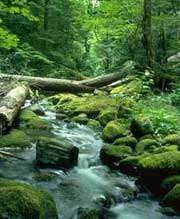Survey of U.S. Streams Finds Numerous Contaminants

Many chemicals commonly used in medications such as over-the-counter painkillers or birth control pills end up far from their intended destination – in American streams. According to a new report, published online today by the journal Environmental Science and Technology, a number of the waterways contain complex cocktails of compounds.
The 30-state study, conducted by the U.S. Geological Survey, tested 139 streams for 95 organic contaminants – ranging from medications and hormones to insecticides and fire retardants–between 1999 and 2000. In 35 percent of the waterways, the researchers found 10 or more compounds and 80 percent of the sites harbored at least one chemical. In one particularly polluted stream, the team detected 38 contaminants. The most frequently encountered compounds included the steroids coprostanol and cholesterol, the insect repellant DEET, triclosan (the active ingredient in antimicrobial soaps) and caffeine.
Because this was the first attempt to clarify the distribution of these so-called pharmaceuticals and personal care products (PPCPs), the scientists specifically chose streams likely to display contamination such as those near urban areas or livestock production facilities. Thus, they should not be considered representative of all streams in the U.S. And although the plethora of pollutants is discouraging, most of their concentrations were low, often measuring less than one part per billion. The scientists note, however, that some hormones can affect aquatic life at exceedingly low concentrations and that the potential toxicological effects of many of the detected chemicals remain unclear.
Media Contact
All latest news from the category: Life Sciences and Chemistry
Articles and reports from the Life Sciences and chemistry area deal with applied and basic research into modern biology, chemistry and human medicine.
Valuable information can be found on a range of life sciences fields including bacteriology, biochemistry, bionics, bioinformatics, biophysics, biotechnology, genetics, geobotany, human biology, marine biology, microbiology, molecular biology, cellular biology, zoology, bioinorganic chemistry, microchemistry and environmental chemistry.
Newest articles

A universal framework for spatial biology
SpatialData is a freely accessible tool to unify and integrate data from different omics technologies accounting for spatial information, which can provide holistic insights into health and disease. Biological processes…

How complex biological processes arise
A $20 million grant from the U.S. National Science Foundation (NSF) will support the establishment and operation of the National Synthesis Center for Emergence in the Molecular and Cellular Sciences (NCEMS) at…

Airborne single-photon lidar system achieves high-resolution 3D imaging
Compact, low-power system opens doors for photon-efficient drone and satellite-based environmental monitoring and mapping. Researchers have developed a compact and lightweight single-photon airborne lidar system that can acquire high-resolution 3D…





















